www.infoportwine.com
To serve, to drink and to combine.
03/01/04. Gew. 05/03/05 several links;02/09/06;03/01/06;03/01/07;07/04/07;05/05/07;15/03/08.
REGISTER
FOR NEWSLETTER.
Contents:
1. Generally. - 2. Type
or brand. - 3. To decant. - 4. Crust.
- 5. Port tongs. - 6. Glasses.
- 7. Temperature. - 8. To
serve. - 9. To combine. - 10. Some
combinations. - 11. Vintages. - 12. Cocktails.
1.
Generally.
Drinking Port is possible at anytime of day and on every occasion, although we
have to admit that we have never tried it at breakfast ourselves.
It is nonsense to restrict the drinking of Port to an aperatif or dessert. It
can also be delicious with combinations at lunch and dinner, as an after-dinner
drink, a drink at receptions or late in the evening.
A good glass late in the evening has our personal preference.
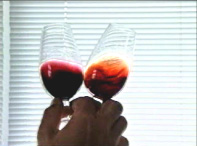 2.
Type or brand.
2.
Type or brand.
You yourself can best figure out which type or brand of Port suits you on
different occasions and in different combinations. Do not let yourself be
governed by any single rule. It is your taste that matters, not someone else’s
or the majority’s. The examples we give in this article are only meant to
provide you with ideas and to set you on your way.
There is an enormous diversity in tastes and qualities within the total Port
offer. Neither the views of producers nor consumers (national preferences, see
Files/Types 1m.) are unanimous.
To determine which Port suits you best, you can organize your own tasting. Take
a dark, fruity LBV (for example Warre’s, Noval or Dow’s) and a 20 years old
Tawny or Colheita. Taste them in turn. Should you prefer the LBV, also give
Reservas and Rubies a try. If you like the 20 year old Tawny best, you should
certainly try other Aged Tawnies and several years of Colheitas too.
Whatever type you may prefer, in both cases you will greatly appreciate the
really matured Vintages.
3. To decant.
Before you open a bottle you should first determine whether it should be
decanted. This is actually not necessary for filtered Ports,
unless you have the experience that aerating the wine does it good. Unfiltered
Ports (see Files/Types 1d) almost always need to be decanted.
When unfiltered Ports have ripened for years the wine will first have to be
separated from the crust. Put the bottle upright where you want to decant it,
preferably at least 24 hours in advance. Try to move the bottle as little as
possible while uncorking and pouring it out in one continuous motion. You often
read that you can see the verge of the crust against the light of a candle, but
the glass of many Port bottles is so dark that this will not be possible. So
stop in good time. There is nothing wrong in saving what remains by pouring it
in a glass through a funnel with filter.
Generally speaking 10 to 20 years old Vintages can be decanted
some hours before, but with the older ones this is best done just before serving.
However,
in the Port Wine industry it is very camion to get a Vintage from the cellar
shortly before consumption. 07/04/07. Paul Symington has the following
comment on this: “To decant, simply stand the bottle up-right for half an hour
or so, pull the cork with care, leave the bottle for a few minutes and then pour
into a clean jug or decanter. The natural sediment will easily be left in the
bottle if poured with a steady hand.”
At
http://www.fortheloveofport.com/index.php?option=com_content&task=view&id=81&Itemid=67
you can find much more useful advices from him, Christian Seely and George
Sandeman, including about the differences in maturing by storage conditions and
the double decanting of still too young Vintages.
The
American Port guru Roy Hersh propagates a very different approach, though he is
the first to call his views controversial. He was inspired by, amongst others,
the in 2002 deceased celebrity Bruce Guimaraens (Fonseca). Hersh recommends the
following times between decanting and serving:
-
7
years or less: 10 - 12 hours,
-
8
- 15 years old: 8 - 10 hours,
-
16 - 25 years old: 6 - 8
hours,
-
26 - 35 years old: 4 - 6
hours,
-
36 - 45 years old: 3 - 5
hours,
-
46 - 60 years old: 2 - 3
years,
-
60 years old: 1 - 3 hours.
However he also indicates that differences within a harvest year can be
necessary. An extensive article by Roy Hersh about this subject can be found at:
http://www.fortheloveofport.com/articles/decanting.htm
In his book “A Winelover’s Guide to Port”, João Paulo Martins recommends
not to decant very old Vintages, Tawnies and Colheitas. He considers them to be
too delicate.
4.
Crust.
It would be a waste to throw away the crust. It can be used, with or without
some Port, in all kinds of dishes.
In her brochure Porto (Icep New York), Pasquele Iocca recommends to serve the
crust on a piece of toast the next morning.
5.
Port tongs.

It can be difficult to remove the cork if a bottle is very old. The use of port
tongs can then come in handy. Many good wine shops and some auction sites
offer Port tongs.
Make sure the jaws of the tongs red- to white-hot and clasp them for 1 to 2 minutes firmly
around the neck of the bottle a little below the cork. If you then fold a wet,
ice-cold cloth around the neck, the glass will break without splinters.
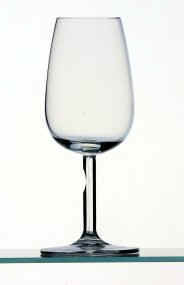
6.
Glasses.
Port Wine always deserves a good glass. It should be tulip-shaped and not too
small. You should be able to swirl and smell the wine.
The official glass of the Port industry is the best choice for a fair price (see
our News item of 20/04/02). It has been designed by the Portuguese architect Álvaro
Siza Vieira in commission of the Instituto dos Vinhos do Douro e do Porto and in
cooperation with the AEVP (organization of the large shippers). This glass is
available in all IVDP establishments, in some wine shops and at some auction
sites.
Riedel’s specially designed crystal glasses for Port are really out of the
ordinary, but also expensive. See: www.riedel.com and link
“Collections”, “Wine & Glass Guide” and
“LBV, Tawny or Vintage”.
But if none of these glasses is available, take a not too large, tulip-shaped
glass for table wine for example the one for white wine.
Many years ago his doctor told a member of the Sandeman family that he could
have only one glass of Port a day. So he had a special glass made … it could
hold a whole bottle.
7. Temperature.
Port is very often served too warm. This makes the drinking unpleasant as the
alcohol becomes too prominent. Too cold is less critical as you can postpone
drinking for a while or warm the glass with both hands a little. We always
drink our Port Wine (all types) from the fridge in hot summers.
Pedro Tiago Serpa Oliva, manager of the Solar do Vinho do Porto in Lisboa, told
us in May 2003 that he always keeps his Ports for group tastings in the fridge. They are
exactly the right temperature at the time they are poured out and served.
White Port is always served chilled, the dryer the Port the cooler.
In the Portuguese magazine Revista de Vinhos of August 2002, João Alfonso
recommends a temperature of 13-16°
Celsius for old Tawnies and Colheitas and a temperature of 15-18°
C for Vintages.
In the Dutch newspaper De Telegraaf of 25/07/03, Huyshe Bower of Taylor’s
recommends 10°
for old Tawnies and Colheitas and 12°
C for Vintages. He also recommends 12°
C for Ruby and for the other red Port types.
8. To serve.
Serving Port Wine is surrounded with myths and traditions.This is not strange
for a drink so closely associated with British social life, both past and
present.
Traditionally, Port always moves around the table in a clockwise direction,
therefore from right to left. The host fills the glass of the guest on his right.
He then passes the Port to the guest on his left who, in his turn, pours out the
host ‘s glass and so on.
One of the explanations of this is that it was seen as sign of friendship and
peace to the person sitting on his left. Pouring a glass of Port with your right
hand would prevent you being able to draw your sword or revolver.
A more practical reason is that the majority of people is right-handed making it
easier to pour the wine with the right hand and pass on with the left.
This subject is discussed futher at the Sandeman website. See: www.sandeman.com/ing/dadosf.asp?cat=2&id=27
If a guest passes the Port incorrectly, he might be told that his “passport is
out of order” or could be asked whether he knows the Bishop of Norwich. This
“signal” does not require an answer, but should result in passing the Port.
If unfortunately the guest does not understand the “signal” and answers that
he does not know the bishop, the only correct response is: “The Bishop is an
awfully good fellow, but he never passes the Port!”
Using a decanter with a rounded bottom can prevent the problem of not passing
the Port. The Port then has to be passed around until the bottle is empty or at
the most can be put in a holder in front of the host.
9. To
combine.
We gladly match our Port in the late evening with a selection from: really dark
chocolate, fresh chetnuts, walnuts, mixed nuts with raisins, cream cheese with
ginger, hard cheeses (old Gouda) sometimes paired with quince marmalade or some
home made apple spread, 20+ cumin cheese from Leiden, and sometimes with sausage
or ham types. In short, a very personal, but also partly locally determined
taste.
The much mentioned and praised combination of Vintage with Stilton cheese
certainly does not have our preference. We think the taste of most blue cheeses
is too pronounced.
But here also applies: don’t be dogmatic, there is no accounting for tastes.
Select what you prefer yourself and don’t forget to also try products from
your own region. The combinations list of the IVDP (see 10) can perhaps be of
some help.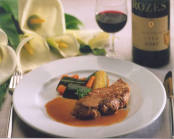
With regard to main dishes the pairing of Steak au Poivre/Pepper Steak with LBV
or Vintage has by now become renowned.
Cigar smokers can be very enthusiastic about the combination with Port, but a
veil of cigar smoke will adversely affect your ability to appreciate the aromas
and flavours in your glass.
Good manners dictate that smoking should certainly not commence until the second
passage of the decanter or bottle. For combinations with cigars see: www.realcompanhiavelha.pt/i_charutos.cfm
You can gain other ideas about matching on many sites on the Internet. Here are
some links:
www.calem.pt/client.asp?fc=createpage&URL=client/skins/english&name=especialista
and then choose Gastronomy (extensive suggestions).
www.cockburns-usa.com/about_port_pairing.html
(well organized table with appetizers, main dishes and desserts).
www.martinez.pt/cgi-bin/sugestoes/pormenor.php?id=1
(some recipes for desserts).
www.realcompanhiavelha.pt/chocolate.cfm
www.sogrape.pt/gourmet
(with many combination advices and a special taste disc).
www.taylor.pt/food.asp
(with cheese and dessert combinations).
10. Some
combinations.
In 2003 the Instituto dos Vinhos do Douro e do Porto (IVDP, formerly IVP) has published
an extensive list of combinations. We have made the following selection:
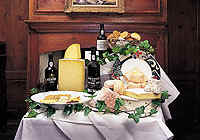 White
Port:
White
Port:
Canapé with capers.
Canapé with salmon caviar.
Canapé with pink shrimps.
Canapé with smoked salmon.
Filled green and black olives.
Different nuts.
Ruby / Reserve:
Canapé different cheeses.
Red wild fruit tart.
Fresh fruits salade with Port.
Aged Tawny / Colheita:
Dried plums, apricots and apples.
Goose livre pâté.
Pork pâté.
Dates fold round with bacon.
Dried figs.
Currants and raisins.
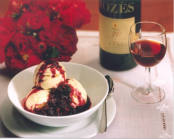 Nuts
cake with sugared fruits.
Nuts
cake with sugared fruits.
Pie with caramelized apple slices.
Sorbet ice of almonds and caramel.
Gouda cheese with quince marmalade.
Frisian clove cheese.
LBV / Vintage:
Chocolate cake.
Strawberries sealed with chocolate.
Stilton, Roquefort.
11.
Vintages.
Don’t be stingy when drinking Vintage Port Wines. You should carefully decant
the bottle but keep in mind that the wine quickly oxidizes after contact with
the air. Sometimes is said that it will keep for another 24 hours, but it will
never ever improve. So please drink up and especially enjoy it to the full.
For information about Vintages for drinking now see Files/To
store ...
12.
Cocktails.
Most people will not give Port in cocktails a second thought.
Nevertheless, the Portonic has become a great success. It is made with equal
parts of Dry White Port and tonic, with a slice of lemon or lime and one or two ice
cubes. The versions with Sweet White and Light Dry White should also be given a
try. The Portonic is served in a high, narrow long drink glass.
See also:
-
www.gporto.com choose “G Cocktails”.
- www.sandeman.eu/pleasure/cocktails/en
-
www.realcompanhiavelha.pt/i_noticias.cfm?s=6&ss=8
with the Caipiroyal.
Copyright
© 2001-2011 infoportwine
All rights reserved.

 2.
Type or brand.
2.
Type or brand.



